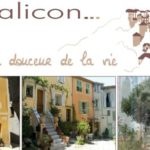After passing the Saint Michel area, we leave the urban zones and encounter the terraced fields cascading down the slopes of the hills and Mount Chauve.
The sky is azure blue, and the bustling city appears on our right. Today, the Mistral plays its symphony, and we can see planes slicing through the horizon as they approach the airport. The olive trees reign supreme, extending their centuries-old branches. We pass the small chapel of Saint Michel and continue toward this eagle’s nest where Queen Victoria and the writer Jules Romain used to frequent.
The village of Falicon welcomes us, with two old men sitting in the shade of a tree staring at us. We will certainly be the topic of their conversation tonight. We think of Brassens, guided by the grandmothers behind their shutters.
The name Falicon may have Celtic origins and suggests a linguistic blend between the words for cliff and falcon. It must be admitted that this synthesis is perfect, as the village’s altitude of nearly 400 meters justifies this explanation. There are records of this town in the mid-11th century in a charter mentioning a chapel of Saint Michel de Barbalate.
The village was contested between the Abbey of Saint Pons and the local lords. Several families held the fief successively, including the Grimaldi, Travacca, Cays, and Rainal families, whose properties were confiscated and sold by the French in 1794. The village followed the fate of the County of Nice and, in 1860, depending on one’s view, was annexed or joined to France.
Two details suggest an annexation: one at the entrance of Falicon and another explaining the Saint Francis gate, both in Italian: “Domenico Quadroni Italiano 1870.” “Porta San Francesco 18 settembre 1876.” In front of the school, an epitaph commemorates the writer Jules Romain who set part of his novel ‘La Douceur de la Vie’ in this village. He frequented the Bellevue restaurant, now the Parcours Live Restaurant.
The church of Notre Dame du Mont Carmel or the Nativity dates back to 1624 and was built by the Abbey of Saint Pons. The White Penitents have their chapel, the Holy Cross, behind the church, which was constructed five years earlier. Water reached Falicon in 1895 under the administration of Mr. Léa. If this village is twinned with another town, it’s all due to the rose.
On March 12, 2000, a rose was christened in the name of Falicon by a German horticulturist, and a plaque on a fountain indicates: Merchweiler, with the distance separating this source of pure water from a city with an unpronounceable name. Curious visitors will find the answer a little further on.
Falicon holds its secret and mystery with a pyramid whose origins have sparked much speculation. There is talk of a Gallo-Roman temple or a Templar monument. This edifice marks the entrance to the grotto of Mount Chauve, and some have proposed theories about a possible treasure.
Let us leave room for dreams and dreamers, concluding as the bus awaits us, with the epitaph inscribed on the school’s front: “This village of Falicon is honored to have inspired in people of goodwill the sweetness of life.”



